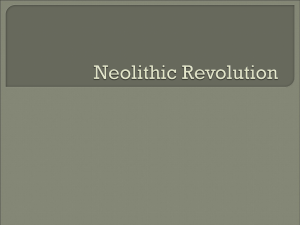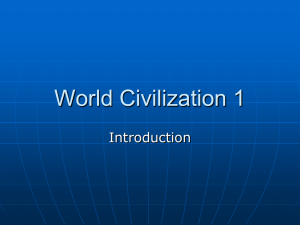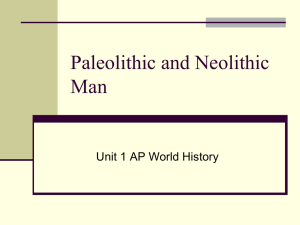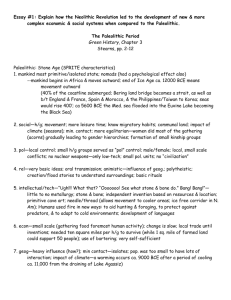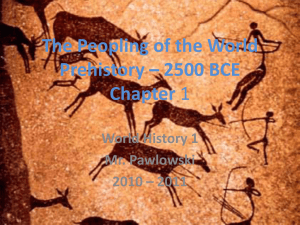Ancient Eastern Mediterranean Societies: Origins & Structures
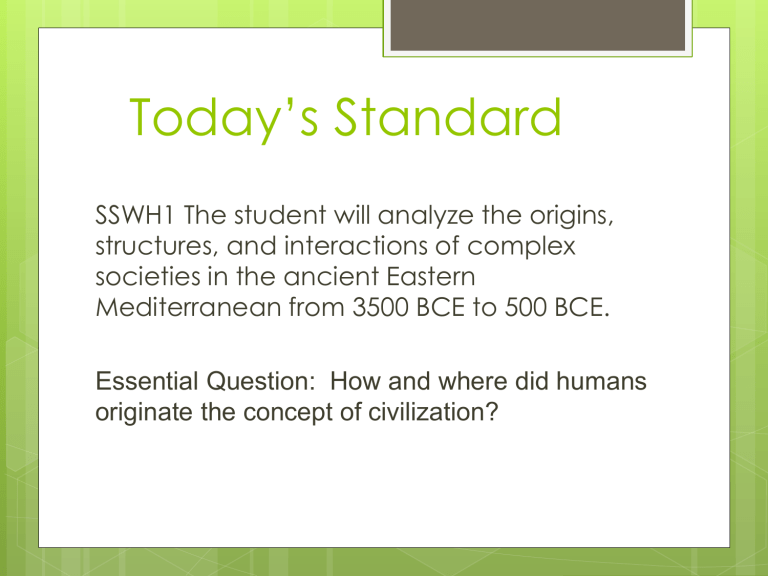
Today’s Standard
SSWH1 The student will analyze the origins, structures, and interactions of complex societies in the ancient Eastern
Mediterranean from 3500 BCE to 500 BCE.
Essential Question: How and where did humans originate the concept of civilization?
Early Peoples through the
Agricultural Revolution
Scientists Who
Study Prehistory
Anthropologists
• Study human cultures, both past and present
• Cultures are the ways that groups of people live and see the world
Archaeologists
• Excavate the sites where human beings used to live
• Examine the artifacts
(objects made by human beings) that cultures left behind
Paleontologists
• Study fossils
• Fossils are evidence of life preserved in rocks
Prehistory is everything that happened before written records.
Prehistory
Writing developed in different places at different times.
This means that, technically, the dates for prehistory vary around the world.
Historians using the term prehistory are generally referring to time before the very first human writing, about 5,000 years ago (circa 3000 BCE).
Key characteristic:
Walk upright
Hominids
Oldest human-like skeletal remains ever found
3-4 Million Years old
Found in Africa
Discovery has been questioned lately over the species of the find
Lucy
First Humans
Characteristics
Powerful jaw
Receding chins
Low foreheads
Heavy eyebrows
More First Humans
Hunter/gatherers
Nomadic
Traveled in clans of
40-50
Men hunted while women gathered nuts/berries/seeds
Homo Sapiens
Appeared on the scene between
100,000 and
400,000 years ago
Several over 1.7 million years
Warm era that we live in today started about
10,000 years ago – coincides with last ice age
Ice Ages
First Homo Sapiens
Neanderthals
Appeared 35,000-
130,000 years ago
(Old Stone Age)
Wore animal skins
Used fire
Buried their dead
Cro-Magnons
Appeared about
35,000 years ago
Better tools
Cave Art
Textbook
History lessons
Religious
The Stone Age
Although there is some overlapping in some parts of the world, prehistory is roughly equivalent to the Stone Age.
The dates used by historians and archaeologists typically refer to the earliest time that some turning point occurred.
For example, the Sumerians of Mesopotamia developed writing thousands of years before writing was used by European tribes.
The time period when Sumerians were literate and Europeans were illiterate is considered historical as opposed to
prehistorical because writing existed in the world (even though
Europeans weren’t using writing yet).
The Stone Age is divided into two parts:
Old Stone Age – also called the Paleolithic Age
New Stone Age – also called the Neolithic Age
This shows how a point was made from rock.
Prehistoric
Stone Tools
Old Stone Age
• Paleolithic Age
• 2,500,000 to 8000 BCE
• Made stone chopping tools
• Hunter-gatherers
• Humans migrated across the globe
• End of the Paleolithic coincided with the end of the last ice age
• Modern human beings overlapped with Homo
erectus and Neanderthals
• Cave paintings and small carvings
The Stone Age
New Stone Age
• Neolithic Age
• 8000-3000 BCE
• Humans made numerous tools, as well as jewelry, from bone, wood, stone, tusks, etc.
• Pottery
• Permanent settlements
• Agriculture (farming)
• Animal domestication
• Modern human beings left as the only hominids on the planet
The Last Ice Age
Humans (nomadic hunter-gatherers) spread out across the globe (in bands of 25-70 people) in search of game and edible plants.
• The ice created a bridge between what we now call Siberia and
Alaska. Humans crossed this bridge to North America and spread to South America very quickly.
The ice age ended about 10,000 years ago (8000
BCE), leaving humans living all over the world.
• The ice bridge between Siberia and Alaska melted, leaving humans in the Americas separated from the rest of the world.
Temperatures increased, creating a longer growing season. The ice receded, making the land drier and better for growing plants. During the ice age, a lot of large game was hunted to extinction (like wholly mammoths). The invention of farming allowed people to maintain a steady food supply.
The Agricultural
Revolution
The Neolithic Revolution is also called the Agricultural
Revolution. People developed farming for the first time.
For generations, humans had noticed plants growing where they had spit out seeds.
Humans began planting seeds on purpose, which was the invention of farming.
The first farming method was slash-and-burn. Farmers burnt grass and trees to clear a field. The ashes fertilized the soil. Farmers relocated every few years after exhausting the soil.
People continued to hunt, returning to their farms to harvest their crops.
Eventually, people built permanent homes near their farms so they could store and guard their grain.
Permanent homes made following game difficult.
Eventually, farmers domesticated animals, such as cattle, goats, pigs, and sheep. Animals ate farm waste while fertilizing the soil.
Neolithic Village
Skara Brae, Scotland
Agriculture around the World
Africa
(Nile
River
Valley)
Central
America and
Mexico
China
India
(Indus
River
Valley)
Iraq
(Mesopo tamia -
Fertile
Crescent
)
Peru
5000 BCE 5000 BCE
6000 BCE -
Millet
5000 BCE 5000 BCE 3000 BCE
Wheat, barley
Beans, corn, squash
5000 BCE -
Rice
Cotton
Wheat, barley
Tomatoes, potatoes
The oldest-known village in the world existed in Jericho (in
modern-day Israel) in 9000 BCE.:
Catal Huyuk
One of the world’s very first permanent settlements
Populated 7500-5700 BCE
Located in what is now Turkey
Population of approximately 6,500 people
1,000 dwellings crammed together like a honeycomb
No streets – people climbed out through ladders in their ceilings
Supported by agriculture and animal domestication
Barley, peas, wheat
Cattle, sheep
Famous because it is so well-preserved
Catal Huyuk
Mother goddess from Catal Huyuk.
Typical Catal Huyuk interior (restoration).
Wall mural of Catal Huyuk.
Settled Community vs. Nomadic Life
Pros
• Common culture expressed
• Mutual protection
• Near farms
• Grain and seed storage
Cons
• Disease spreads more rapidly among a dense population
• Grain stores were tempting to raiders
• Permanent settlements suffered from natural disasters (drought, fire, floods)
3.
4.
5.
1.
2.
6.
7.
Characteristics of Civilizations
Organized governments
Religion
Jobs
Social Classes
Art and Architecture
Public Works
Writing
Agriculture to Surplus Production
People began to grow more food than they would need – allowed people to do things other than farming
20
18
16
14
12
10
8
6
4
2
0
Establishment of Towns/Cities
With surplus populations could grow
Families now could be larger
Division of Labor
In towns/cities people could specialize in one job or another
Form of Writing
Needed for communication
Early forms were cumbersome with too many symbols
– became better as time past
